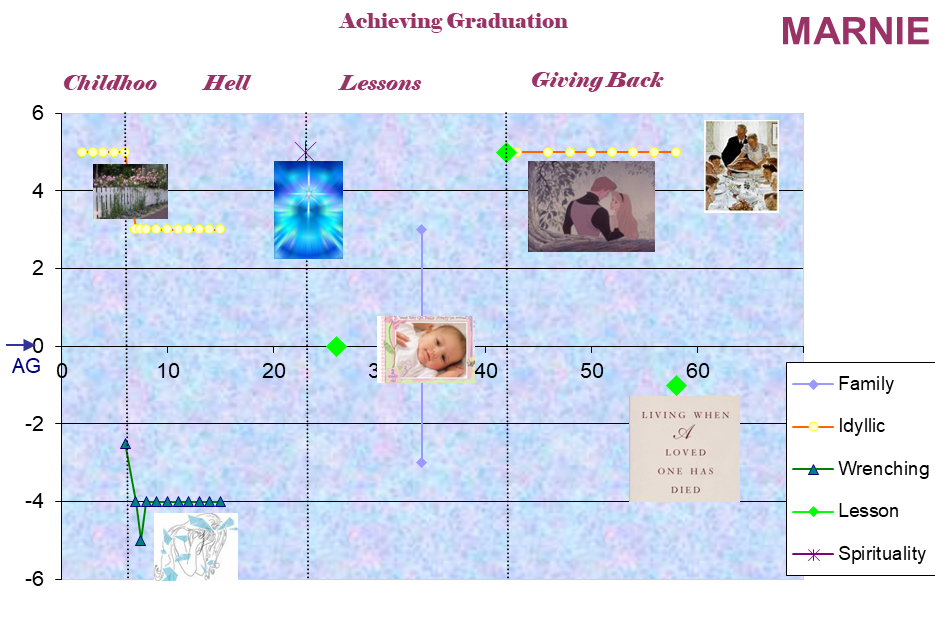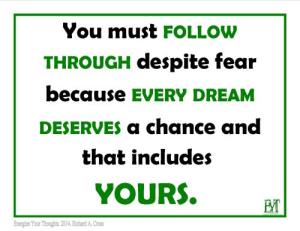Before continuing with the LifePath Mapping stages I have been presenting for you over the last few posts, allow me to give you some notion of where this is headed and how you might stand to benefit from engaging with this self-discovery process. So, I will share a couple of stories from people who have completed a life mapping process. Then I will present the next step of how to discover and name your Life Chapters.
Above you see a Life Story Map composed for a woman I call Marnie (her self-assigned fictional name). Notice how Marnie’s five Life Themes are represented in relation to key Shaping Events from her life. And notice she has identified four Life Chapters (using the simple method I will provide for you later in this post). Marnie had a “white picket fence” early childhood, as she recalled it, with relative happiness and innocence until her beloved father died. This critical life event was followed by a long period Marnie refers back to as living in Hell. She struggled with depression and hardships until finally she could leave home and begin her independent adult life. When she was around 22, Marnie discovered a spiritual teaching that she has dedicated herself to studying and growing from ever since. She attributes many Life Lessons to her awareness gained from her spiritual practices. Then around age 40, after having welcomed the birth of her daughter before divorcing her first spouse, Marnie eventually found someone she could truly love and enjoyed a relatively idyllic relationship with her spouse until cancer eventually claimed her partner’s life. But Marnie’s love for her daughter and family in general leads her to title her current Life Chapter as Giving Back… to her daughter (now as a grandmother of three), to her community (as a volunteer grief counselor for the local fire department), and to her spiritual community for which she serves in a leadership role.
While Marnie was engaged in life mapping she discovered how different archetypal facets of her self have been influencing her outlook in different life chapters. While processing these various and often conflicting ‘parts of Self’ attitudes, she came to resolve some lingering feelings about the early “wrenching” times in her life. As she looked forward to her future life path, Marnie expressed a life goal of continuing to serve life and to unfold spiritually, and she hoped she could maintain closer family relations. Shortly after that, her daughter chose to relocate to live much closer to Marnie’s home and she has enjoyed her role of active Grandmother ever since her daughter’s first baby was born.
The second case study I would like to share is an even more monumental sort of success story resulting from LifePath mapping. I worked with Mindy over a period of around nine months when she was 45 to coach her through a full life mapping process. This approach takes shorter or longer depending on how much attention a person gives especially to the central, “transitional/ transformational” stages that provide for a depth analysis engaging with archetypal parts of Self one identifies with their Life Themes (as I will present activities for later on with these posts).
As Mindy began her LifePath Mapping process she soon came to recognize a disruptive long-term pattern in her life. She realized that she had a deep internal conflict that had caused her to vacillate between jobs, relationships, and locations over many years. She would start a relationship with a man, or embark on a new job, or move to a new location on a nudge (sometimes in combination), but shortly after her attempt to find stability with these bold moves, doubt would set in and soon she would respond to new nudges, this time to BOLT from her new relationship, job, and/or location.
Two of the Life Themes Mindy identified were associated with “Physical” and “Spiritual” events. Notice in her Life Story map shown above how these events created polar opposite effects in her life, with Physical events consistently rated -5 and Spiritual events, +5. When asked to associate her Themes with Archetypal personas–(I will be introducing this approach to you to later on, so stay tuned)–, Mindy identified a Warrior archetype with her Spiritual theme, and a Descender archetype with her Physical domain.
I encouraged Mindy to engage in a “dynamic archetype dialogue” journalling activity, inviting her Warrior and Descender parts-of-Self to converse with each other around a common ideal Goal she had associated with both of them: Freedom. This turned out to be enormously enlightening, as she learned how her Warrior would send spiritual nudges to promote the Freedom to embark on positive, life enhancing new directions, but then her Descender would react, seeking Freedom in the form of bolting away from any limitations or from feeling hemmed in by the new circumstances. So next, Mindy engaged these two parts-of-Self in dialoguing about how they could mitigate their conflict. Mindy decided she should seek out a job that involved moving to various locations or dealing with various sorts of projects.
Around two years after Mindy had completed her life mapping process with me, she called me from a state far away to tell me how excited she was about how her life was going. She had taken a job as an educational lecturer/ salesperson for a company with many diverse products, so indeed she was in her element with variety and educational service and the products she was promoting were health oriented, which also satisfied her Spiritual persona. As well, some time into the job she had met a man and remarried. They lived together in Oregon between her job trips around the country and they always gave each other plenty of space. She had resolved her conflict by understanding its psychological roots and utilizing the strengths of her complex self rather than merely suffering from its polarities.
****** ******
Discover Your Life Chapters
Now then, let’s add the next step in LifePath Mapping as I am presenting the process for you here.
So far (see previous posts if you need to catch up), you have identified a set of Shaping Events; you have sorted these events into categories of types of events and named these categories as your recognized Life Themes; and with the previous post you plotted these Themes on a graphic Life Themes Map by using Theme color-coded points and linkages to plot the relative impact ratings of the Shaping Events related to each of your Themes.
Next then, I would like you to go back to your original list of Shaping Events, and this time as you read through these significant moments and/or situations from your life, please identify which of these Shaping Events were of such momentous impact in your life that you may feel you were “not the same person before and after that event or situation occurred.” List those separately. These are your Critical Life Events.
Once you have identified your Critical Life Events, which usually will be far fewer in number than all of your Shaping Events—maybe two to four or five or so—then look back at your Life Themes Map and draw dotted or hash mark lines vertically from the top to the bottom of your map in accordance with the AGE points along your Age Line when each of your Critical Events began.
Now you can look at the time frames BETWEEN your Critical Events that you have marked off vertically across your Life Themes Map. These time frames embody Life Chapters for you in association with your Life Themes. This makes a lot of sense psychologically since the Critical Events by their very nature have served as ‘boundary markers’ of momentous shifts in your life experience.
So look over your Life Themes Map with Life Chapters demarcated, and now you can NAME your Life Chapters. Think of this mapping as being like a story script. That is what it shows: your Life Story, with your very own Themes and Life Chapters. Provide narrative titles for each of your Life Chapters which are meaningful to you and that reveal the plot structure of your Life Story over time.
free stock images are from pixabay.com
Next time I will begin by discussing the sorts of Life Chapter sequences people most often identify with their Life Stories, and we will proceed from there to a technique for discovering a Parallel Myth that reveals the mythic structure and import of your own heroic adventure.
I apologize for delaying several weeks between the last post and this one. Much is happening in my own Life Story, too!
Again, if you wish to discuss this process or take it further than these posts, you could reach me at lwatts@uccs.edu. (If you may have done so with my not responding yet, your message might have gone to spam mail, which as a fixed rule I never read. You could leave a note to that effect in the Comments area below and we can work out a way to get connected.)





















